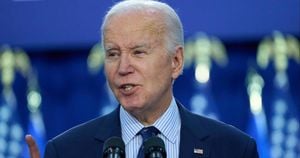Myanmar is engulfed in civil war, with the devastating conflict taking on new global dimensions. The chaos began after the military coup of February 2021, when the democratically elected government led by Aung San Suu Kyi was ousted. Since then, the country has spiraled downward, marked by violent clashes and widespread displacement, with both local and international players significantly influencing the conflict's progression.
The war is not just of local concern. Various foreign powers are deeply involved, each with their own strategic interests at play. China, for example, continues to be a major influence, both economically and militarily. According to Dr. Adam Simpson, an expert from the University of Adelaide, the complexity of China's position cannot be overstated. While it has historically supported different ethnic armed groups, it now finds itself estranged from the military junta due to the changing dynamics on the ground.
China has been known to engage multiple parties within Myanmar's civil war, supporting factions like the Myanmar National Democratic Alliance Army (MNDAA) and the United Wa State Army, organizations linked to the Chinese ethnic populace. Amidst the conflict's developments, some recent military successes of the opposition have raised eyebrows within Chinese circles, indicating potential shifts in China's involvement.
Notably, recent victories by Myanmar's resistance groups have caused Beijing to reassess its support. For years, it had favored stability owing to its substantial investments, including key gas and oil pipelines. Yet, its dual-game strategy faces risks, particularly with rising anti-China sentiments among the local population, exacerbated by events like the bombing of the Chinese Consulate.
Russia also plays a pivotal role, having cemented its relationship with the military junta under circumstances parallel to its own isolation following the invasion of Ukraine. Since 2021, various entities from Russia have funneled at least $406 million worth of military hardware to Myanmar’s armed forces, enabling the junta to continue its brutal campaign against civilian populations. This includes the provision of MiG-29 jets and helicopters, which have been employed to conduct airstrikes on schools and hospitals.
Proponents of the junta, including Russian military senior officials, have visited Myanmar to reaffirm their joint military cooperation. This Russian-Myanmar alliance mirrors the desperate state of affairs resulting from international isolation and domestic strife. With Myanmar’s junta eyeing membership within BRICs, it remains uncertain how this ambition will mesh with China’s overarching influence in the region.
Despite global actors like China and Russia being relatively influential, others like ASEAN and Western nations have found themselves sidelined. ASEAN has wrestled with the junta's ascendance, striving for unity but often falling short, occasionally refusing the junta’s representatives from attending high-level meetings. Their ‘Five Point Consensus’ has largely been ineffectual, with more substantial support needed from Western countries to ally with Myanmar’s democratic forces.
This geopolitical tangle is compounded by local narratives and community resilience. Amidst the violence, Myanmar’s cultural and historical fabric is still being woven. Artisans are enduring the hardships of civil strife, exemplified by sculptors like Aung Naing Lin, who painstakingly carve Buddha statues using marble sourced from delicate quarries now controlled by rebel forces.
These artisans confront the harsh realities of economic survival against the backdrop of civil war. The man who creates Buddhist statues noted the challenges he faces transporting precious materials through conflict zones, illustrating the personal impacts of war on individuals striving to maintain cultural continuity.
The situation showcases the stark divide within the nation—the junta’s military machinery colliding with widespread public dissent. The burgeoning People’s Defence Forces (PDF), composed of citizens rising against the military's oppressive reign, have increasingly become central players amid the tumult. They oppose the ruling military's classification of them as “terrorists,” showcasing how the local narrative is often at odds with international perceptions of the conflict.
Artisans hope their work may contribute to societal healing, lifting the spirits of those beleaguered by war. The creative spirit persists across the challenges; for many artists, nurturing and crafting these statues is not merely business but an act of honoring tradition and fostering hope.
The civil war's far-reaching consequences extend beyond Myanmar's borders, stirring broader regional instability. Neighboring countries brace for the fallout, particularly concerning the flow of refugees, arms, and illicit goods. Thailand has historically been impacted by the conflicts spilling over from Myanmar, presenting dilemmas related to national security and humanitarian responsibilities.
The Myanmar crisis is hence part of a larger puzzle, one intertwined with global dynamics. Countries worldwide are challenged by how best to navigate their responses—whether through diplomacy, humanitarian aid, or even military engagement. The world watches as protracted violence continues, the stakes for both civilians within Myanmar and foreign powers becoming ever more complex.
Understanding Myanmar's civil war surpasses conventional notions of regional conflict; it beckons scrupulous examination of international relationships and engagements. What began as a rupture within Myanmar's borders has evolved, with far-reaching ramifications challenging nations both near and far. The road toward resolution, peace, and stability remains fraught with obstacles, as the resilience of the Myanmar people continues to battle against forces from both within and without.



